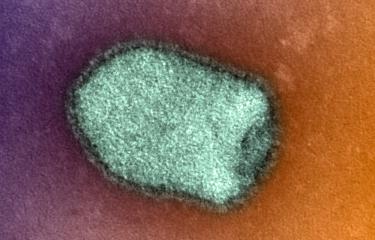A study by teams from the Institut Pasteur du Cambodge and the Institut Pasteur in Paris confirms the efficacy of the new post-exposure rabies vaccination schedule developed in the Institut Pasteur International Network and adopted by the World Health Organization (WHO).
Since 2018, WHO has recommended post-exposure vaccination for rabies, immediately after a bite by a suspected rabid animal, in three sessions over a week instead of the previous recommendation of four sessions over a month. "It was the scientific data that we collected in Cambodia which led WHO to change its recommendations," explains Arnaud Tarantola, Head of the Epidemiology and Public Health Unit at the Institut Pasteur du Cambodge from 2011 to 2016, now based at the Institut Pasteur in Paris. "These data were shared with the experts at WHO before publication. The results of the clinical-epidemiological study on the outcomes of patients who received a shortened schedule were then published in 2018 (1), and we are now publishing the serological study (2)." The new study, published on September 28, 2019, confirms that the fourth rabies vaccination session provides no additional benefit for patients in terms of immunity. With a global strategic plan in place to eliminate dog-mediated rabies by 2030, the adoption of this shorter post-exposure vaccination schedule will play a key part in controlling rabies among billions of people in more than 150 endemic countries.
Eliminating dog-mediated rabies in humans
Since 2015, an international WHO/OIE/FAO*-led effort has been under way with the aim of eliminating dog-mediated rabies in humans by 2030. Seventeen of the 32 institutes in the Institut Pasteur International Network are based in rabies-endemic regions. "In recent years, our research and application capabilities have led to significant advances in the fight against this viral zoonosis," says Arnaud Tarantola. "The Institut Pasteur International Network has a central role to play in research on rabies – its institutes are unique in that they are based in regions where rabies circulates, and they also bring together vaccination capabilities, virological expertise and epidemiology units, staffed by scientists with a thorough knowledge of the subject, on a single site." Research and medicine are therefore closely linked within the International Network, supported by the WHO Collaborating Center in Paris (page in French). "The adaptation of the post-exposure vaccine schedule is a clear example of the introduction of new rabies control strategies in countries in the southern hemisphere," explains Hervé Bourhy, Head of the WHO Collaborating Center for Rabies and the Lyssavirus Dynamics and Host Adaptation Unit at the Institut Pasteur in Paris.
*World Health Organization (WHO), World Organization for Animal Health (OIE), Food and Agriculture Organization of the United Nations (FAO).
Rabies, a disease that still kills in 2019
Rabies (see our disease fact sheet) is a viral zoonosis that is invariably fatal once the first clinical signs begin to occur. The Institut Pasteur, which celebrated its 130th anniversary in 2018, was set up following the success of the rabies vaccine developed by Louis Pasteur and his team. But rabies is still a major public health concern for developing countries, especially in Africa and Asia, where approximately 30 million individuals receive treatment for bites and at least 60,000 die each year, 40% of them children.
In Cambodia, where rabies kills an estimated 800 people annually, nearly 600,000 severe dog bites occur each year (see our 2017 article on rabies in Cambodia). Almost all rabies cases in humans are caused by bites from rabid dogs: efforts to eliminate human rabies are primarily based on canine rabies control.
An effective vaccine used immediately after a suspected rabies bite
Rabies can be controlled by the currently available vaccines.
- The human rabies vaccine is prescribed after a bite from a suspected rabid animal (post-exposure prophylaxis) to prevent the virus spreading from the inoculation site to the central nervous system. It is also used preventively in individuals exposed in a professional context and recommended for travelers to endemic areas.
- The canine rabies vaccine, when administered on a large scale, stops the virus spreading among the canine population.
These two vaccine approaches have led to the elimination of human rabies transmitted by dogs in large parts of Europe, the Americas and most developed countries, but they are not used widely enough in Africa and Asia, mainly because of the high cost and logistical difficulties.
It goes without saying that tackling rabies also involves prevention: "We need to emphasize how important it is for tourists to be vaccinated before they travel to exposed countries," explains Arnaud Tarantola (see "Préparer son voyage" - Preparing to travel abroad - page in French).
WHO recommendations updated in 2018 as a result of Institut Pasteur expertise
The work of the Institut Pasteur International Network provided data that is helping improve the cost efficiency of rabies prevention. In April 2018, the World Health Organization (WHO) updated its recommendations on the use of rabies vaccines and immunoglobulins.
Post-exposure vaccination by intradermal injection of reduced doses following injuries caused by animals (mainly dogs but also cats, ruminants, pigs, monkeys and bats) now takes place in three sessions (days 0, 3 and 7) over a week, instead of four sessions over a month.
Improving patient treatment and access to care
The significant shortening of the vaccination schedule, known as the "IPC protocol" after the Institut Pasteur du Cambodge, is improving patient treatment and offering fairer access to the vaccine, especially for impoverished populations in rural areas. To achieve these results, the teams conducted a retrospective study on clinical outcomes in a large number of vaccinated patients. The scientists demonstrated that there was no increase in mortality in those that interrupted the schedule before the fourth injection (2). Rabies immunoglobulins remain necessary in addition to post-exposure prophylaxis in cases of severe bites in individuals who had not previously been vaccinated.
The IPC protocol is the first post-exposure schedule over a single week to be recommended by WHO. This has raised the prospect of it being funded by Gavi, the Vaccine Alliance, in 47 eligible countries from 2021 onwards. The Institut Pasteur du Cambodge, which treats nearly 26,000 individuals every year who have been bitten by potentially rabid animals, has continued its efforts to tackle rabies with the opening of its second vaccination center in Battambang in 2018 and its third center in Kampong Cham in early 2019.
Sources
(1)· Intradermal rabies post-exposure prophylaxis can be abridged with no measurable impact on clinical outcome in Cambodia, 2003-2014. Vaccine. 16 novembre 2018.
Tarantola A, Ly S, Chan M, In S, Peng Y, Hing C, et al.
(2)· A 1-week intradermal dose-sparing regimen for rabies post-exposure prophylaxis (RESIST-2): an observational cohort study, The Lancet Infectious Diseases, 26 septembre 2019.
Tineke Cantaert1*, Laurence Borand2*, Lauriane Kergoat4, Chanthy Leng2, Sivlin Ung1, Sotheary In2, Yiksing Peng2, Chandara Phoeun2, Chanthy Hing2, Chun Navy Taing2, Manil Saman2, Sivuth Ong3, Channa Mey3, Rithy Choeung3, Sowath Ly2, Philippe Dussart3, Hervé Bourhy4*, Arnaud Tarantola2*
1. Immunology Unit, Institut Pasteur du Cambodge, Institut Pasteur International Network, Phnom Penh, Cambodia ;
2. Epidemiology and Public Health Unit, Institut Pasteur du Cambodge, Institut Pasteur International Network, Phnom Penh, Cambodia ;
3. Virology Unit, Institut Pasteur du Cambodge, Institut Pasteur International Network, Phnom Penh, Cambodia ;
4. Lyssavirus Epidemiology and Neuropathology, WHO Collaborating Centre for Reference and Research on Rabies, Institut Pasteur, Paris, France.
This study is part of the Vaccinology and Immunotherapy Initiative of the Institut Pasteur's strategic plan for 2019-2023.
For more information, please visit









